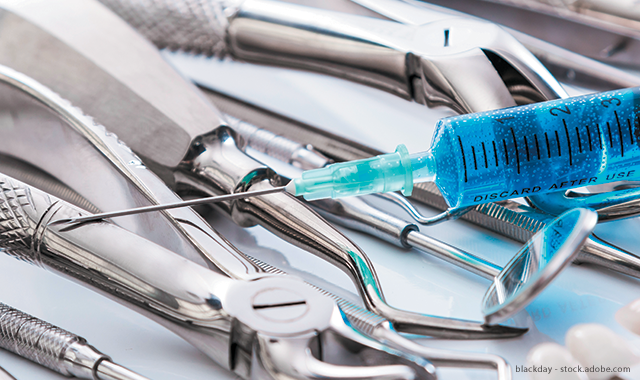Top 5 tips for more effective anesthesia

Invasive dentistry begins and ends with effective local anesthesia. Achieving local anesthesia prior to beginning treatment is not always easy and can be very anxiety-inducing for patients. On the 70th anniversary of lidocaine’s approval by the FDA, here are some tips for achieving effective local anesthesia:
1. Know your rights
Local anesthetics are used every day. Even though the two most popular solutions are lidocaine and articaine, other local anesthetic choices are also available.
The most important things to remember when using local anesthetics are: choose the right drug, at the right time and dose, for the right patient and procedure. To provide the best chance for a positive outcome, providers must combine patient factors (e.g., medical history, allergies, etc.) with procedural factors (e.g., onset, profundity, duration, etc.).
2. Know the basics
Clinicians use local anesthetics each day, but do you remember the basic kinetics of each solution? Do you remember what the terminal half-life of lidocaine is, or what the duration of action should be for plain mepivacaine? What about maximum dosage calculations? Providers should periodically review the basics to prevent complacency and errors.
Read more: Study finds office-based dental anesthesia on the rise
3. Select the appropriate armamentarium

The three essential pieces of local anesthetic delivery are the syringe, needle and cartridge. Although the self-aspirating breach-loading metal dental syringe has been in use for approximately 50 years and hypodermic needles for more than 150 years, do you take full advantage of the features for both?
The highest risk of toxicity following local anesthetic administration is intravascular injection; the innovation of self-aspirating syringe was intended to minimize the risk of inadvertently delivering the local anesthetic within a vessel. According to market data, 27ga and 30ga needles are the most common sizes purchased, despite recommendations to use a 25ga for delivery of an inferior alveolar nerve block. It’s a myth that using smaller needles causes less injection pain, and operators should always consider using the right gauge and length needle.
4. What is old can be new again
Clinicians are continually searching for a method to make local anesthetic injections more predictable and less painful for patients. Buffering (or alkalinizing) and warming local anesthetics are two techniques that have been described for many years but aren’t routinely integrated into dental practice. Recent literature has highlighted both as ways to provide less painful injections and to provide quicker local anesthetic onset and increased profundity.
5. Not everything new and shiny is a diamond
Dental manufacturers are also searching for a better approach to local anesthetic success. There are lots of gadgets on the market to seemingly make local anesthetic delivery easier, better, less painful and more sophisticated. From computer-controlled delivery systems to self-capping needles to sodium bicarbonate mixing systems to intranasal local anesthetic delivery and 96-hour local anesthetic solutions, clinicians have lots of options to expand the basic armamentarium. It’s essential to do your own research to see if these additional local anesthetic tools are appropriate for your patients and practice.